Research
We study the molecular mechanisms underlying plant control over arbuscular mycorrhiza symbiosis.
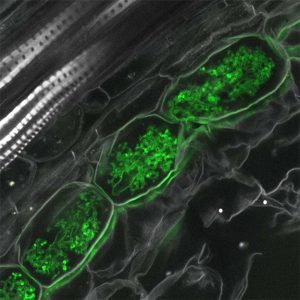 Arbuscular mycorrhiza symbiosis
Arbuscular mycorrhiza symbiosis
To cope with e.g. nutrient scarcity, most land plant species – including crops like soybean or maize – form an intimate relationship with Glomeromycotina soil fungi called arbuscular mycorrhiza (AM) symbiosis.
AM fungi colonize the root cortical cells of their host plant, where they form branched hyphal structures called “arbuscules” (see picture: AM fungal arbuscule is shown in green; plant cell walls shown in white). At the same time, AM fungi form a vast hyphal network surrounding the root, which allows them to take up mineral nutrients such as phosphate very efficiently and from distant locations in the soil. These mineral nutrients are then transferred to the host plant at the host-symbiont interface in the arbuscule-containing cortex cells. In exchange for these benefits, the fungal symbiont receives carbon from the host plant.
Significance
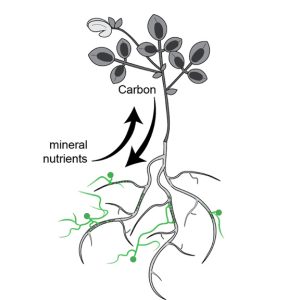 Sustainable agriculture:
Sustainable agriculture:
It is estimated that the human population will reach almost 10 billion by the year 2050, causing global crop demand to increase dramatically. At the same time, present agricultural practices, which include excess application of fertilizers, are not sustainable and often harmful for the environment. Most crop plants, however, can form a symbiosis with AM fungi. Therefore, an efficient use of these microbial symbionts in agriculture could diminish the need for chemical fertilizers. Although AM fungi are increasingly marketed as “biofertilizers” to revive microbe-depleted soils, our limited knowledge on how plants control fungal colonization makes the efficacy of such biofertilizers unpredictable. Thus, if AM symbiosis is to be successfully employed in an agricultural setting it is crucial to fully understand the regulatory mechanisms underlying plant control over fungal colonization.
The carbon cycle:
In addition to benefits to the plant, AM symbiosis has a significant impact on the global carbon cycle: Plants transfer up to 20% of their assimilated carbon to AM fungi, and association with AM fungi increases plant photosynthetic rates. This makes the use of optimized AM symbiosis in agricultural fields not only interesting from a farming perspective but also from a global change perspective, as plants with enhanced AM symbiosis capacities could help capture atmospheric carbon to mitigate the greenhouse effect.
Regulation of AM symbiosis by mobile peptide hormones
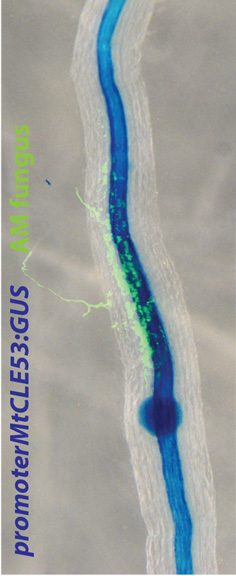 To maintain an optimal balance between symbiotic carbon costs and benefits provided by the AM fungal symbiont (e.g., phosphate), plants tightly control AM symbiosis. One key mechanism is “autoregulation of mycorrhizal symbiosis” (AOM), which enables plants to limit further root colonization by AM fungi once a sufficient level of colonization has been achieved. We discovered that in Medicago truncatula, AOM is controlled by a mobile peptide hormone called CLE53, originating from the roots, and a receptor-like kinase known as SUNN, which operates in the shoots. Increasing the expression of CLE53 in roots reduces the production of strigolactones, compounds that promote AM fungal infection, ultimately resulting in decreased fungal colonization.
To maintain an optimal balance between symbiotic carbon costs and benefits provided by the AM fungal symbiont (e.g., phosphate), plants tightly control AM symbiosis. One key mechanism is “autoregulation of mycorrhizal symbiosis” (AOM), which enables plants to limit further root colonization by AM fungi once a sufficient level of colonization has been achieved. We discovered that in Medicago truncatula, AOM is controlled by a mobile peptide hormone called CLE53, originating from the roots, and a receptor-like kinase known as SUNN, which operates in the shoots. Increasing the expression of CLE53 in roots reduces the production of strigolactones, compounds that promote AM fungal infection, ultimately resulting in decreased fungal colonization.
Plants also regulate AM symbiosis when they can fulfill their nutrient requirements directly through root uptake. This is particularly well-documented for phosphorus, a mineral nutrient that suppresses AM symbiosis when present in sufficient quantities. Intriguingly, the regulation of AM symbiosis by phosphorus appears to involve CLE signaling as well. Our research revealed that a root-derived CLE peptide called CLE33, induced by phosphate, acts as a negative regulator of AM fungal colonization by reducing strigolactone production, similar to the AM-induced CLE53.
We propose that these interconnected yet distinct signaling pathways allow plants to adapt to changing environmental conditions by balancing nutrient acquisition, carbon expenditure, and symbiotic relationships.
Our research projects
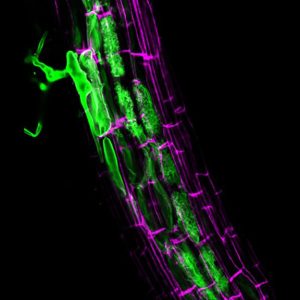 Quantitative and qualitative control of AM symbiosis by the host plant
Quantitative and qualitative control of AM symbiosis by the host plant
Nutrient exchange between the two symbiotic partners is critical for mutualism; thus, plants must balance their carbon expenditure with the symbiotic benefits they receive. However, not all AM fungal species are equally beneficial for a given plant species under given environmental conditions, and interactions can range from highly beneficial for the plant to detrimental (‘mutualism-parasitism continuum’). The host plant tightly controls the AM symbiosis to prevent fungal parasitism, which occurs when the symbiotic costs for the plant exceed the benefits the fungi provide.
The mechanisms that allow plants to control AM symbiosis are little understood. We study the molecular signaling pathways that allow plants to control AM symbiosis based on fungus quantity (how much fungus is already present in the roots?) and quality (do symbionts provide sufficient benefits?), with the goal to uncover novel mechanisms underpinning the regulation of plant-microbe interactions.
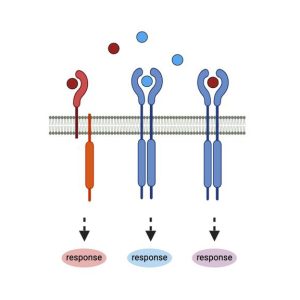 The role of CLE peptides and CLAVATA receptors in plant-microbe interactions
The role of CLE peptides and CLAVATA receptors in plant-microbe interactions
CLE peptides are mobile peptide hormones that – together with their cognate receptors like SUNN (the ortholog of Arabidopsis CLAVATA1) – regulate various aspects of plant development as well as plant responses to environmental cues, including plant-microbe interactions like AM symbiosis and nodulation symbiosis, but also abiotic stress and nutrient availability.
Most plant genomes encode dozens of CLE peptides which respond to different environmental cues, but only relatively few bona fide CLE receptors. This raises the question how plant cells can perceive and specifically respond to distinct CLE signals.
To shed light on this, we study the molecular and cellular mechanisms underlying CLE signaling in the context of plant-microbe interactions, including how CLE peptide signals are induced, perceived, and transduced to achieve specific signaling outcomes.
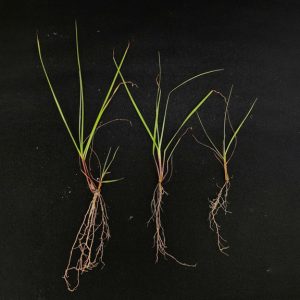 Coordination of symbiosis and development
Coordination of symbiosis and development
AM symbiosis causes physiological changes in the plant that result in enhanced photosynthesis in the shoots and increased carbon allocation to the roots (and, by extension, the microbial symbionts). This typically results in enhanced growth of above- and belowground plant organs; however, the extent of these developmental adaptations appears to depend on the plant and fungal genotypes, as well as the environment.
Although enhanced growth and development is one of the best-documented positive effects of AM symbiosis on the host plant, the genetic mechanisms underpinning the interplay between symbiont presence with plant developmental adaptations remains poorly understood.
We aim to better understand the molecular basis of how symbiotic interactions shape plant development, with the goal to identify genetic pathways that can be altered to create plants with enhanced capacities to benefit from AM symbiosis in a changing environment.